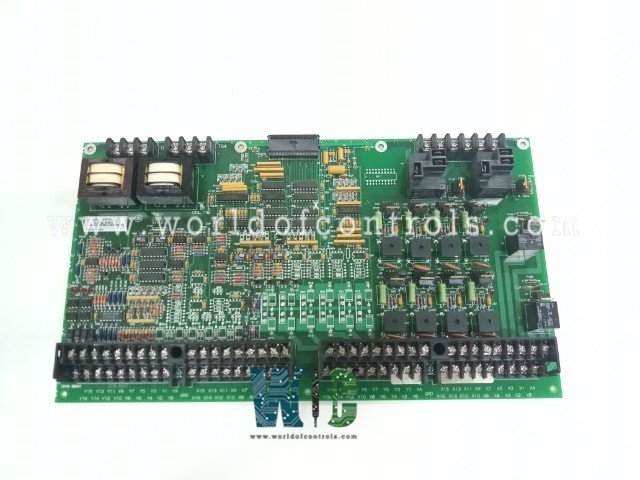
World Of Controls understands the criticality of your requirement and works towards reducing the lead time as much as possible.
DS200DDTBG1A - LCI Auxiliary I/O Terminal Board is available in stock which ships the same day.
DS200DDTBG1A - LCI Auxiliary I/O Terminal Board comes in UNUSED as well as REBUILT condition.
To avail our best deals for DS200DDTBG1A - LCI Auxiliary I/O Terminal Board, contact us and we will get back to you within 24 hours.
SPECIFICATIONS:
Part Number: DS200DDTBG1A
Manufacturer: General Electric
Series: Mark V
Product Function: LCI Auxiliary I/O Terminal Board
Power Requirements: +5 V dc, 6 A
Number of relay channels: 12
Power supply voltage: 28 V dc
Voltage Range: 18 - 32 VDC
Operating temperature: -30 to +65 degrees Celsius
Size: 15.9 cm high x 17.8 cm width
Repair: 3-7 Day
Availability: In Stock
Country of Manufacturer: United States (USA)
Manual: GEI-100219
FUNCTIONAL DESCRIPTION:
DS200DDTBG1A is an LCI Auxiliary I/O Terminal Board manufactured and designed by General Electric as part of the Mark V Series used in GE Speedtronic Control Systems. The DS200DDTB board (DDTB) is a high-voltage terminal board for system connections of auxiliary I/O signals. The board connects to a DS200ADMA (ADMA) analog-to-digital module daughterboard that is mounted on a DS200DSPC (DSPC) digital signal processor control board. High-density connectors and a ribbon cable connect the DDTB to the ADMA board. Power for the DDTB is provided by the ADMA board. The DDTB provides signal conditioning, scaling, buffering, and isolation to make the harsh environment system-level signals accessible to the DSPC board’s digital signal processor (DSP). External wiring connections from high voltage signals, contact I/O, current measurement (via low-level Hall-effect devices), or high-current CTs can be connected to the DDTB terminals. There are G1 and G2 versions of the DDTB board. The G2 lacks some of the functionality of the G1 and is noted where applicable.
FEATURES:
HIGH VOLTAGE AC INPUTS: There are two isolated inputs for connection to high voltage AC signals. These use a step-down transformer, passive filtering, and a buffer to provide a ±5 V peak-to-peak signal to the ADMA board’s VCO inputs (at 693 V rms applied). These inputs have a separate screw terminal block rated and isolated for 1000 V peak transients.
HIGH CURRENT SIGNAL INPUTS: There are six inputs with current sensing resistors suitable for ±5 amp continuous current signals (intended for CT inputs). These are buffered differentially and can tolerate ±12 V of common mode voltage. Each input is filtered and scaled. These inputs have a screw-type terminal block and are protected from voltage surges.
LOW CURRENT SIGNAL INPUTS: There are three inputs with current sensing resistors suitable for ±0.224 amp continuous current signals (intended for LEM current transducer signals). These are buffered differentially and can tolerate ±12 V of common mode voltage. Each input is filtered and scaled. These inputs have a screw-type terminal block and are protected from voltage surges.
4-20 mA CURRENT LOOP INPUTS: There are provisions for reassigning two of either the CT or LEM input channels as receivers for 4-20 mA current loop input signals. This alternate assignment is made by resetting certain jumpers. The input resistance is 192 ohms and the analog input is offset so that 0 mA yields negative full scale and 20 mA yields positive full scale. Open loop detection and input normalization are managed by software.
UNDEDICATED VOLTAGE INPUTS: A differential input voltage amplifier is provided for feeding an analog VCO input on the ADMA board. The gain of this amplifier is 1/2 allowing a ±10 V input signal range. These inputs have a screw-type terminal block and are protected from voltage surges.
4-20 mA CURRENT OUTPUTS: Two of the analog outputs also drive current source output buffers to provide support for the 4-20 mA current loop output signals. Both the voltage and current outputs are active at all times and can be used individually or together by wiring to their respective output terminals. There is an inversion and gain stage in the 4-20 mA driver such that a +5 V input from the ADMA board causes the output to produce 4 mA and a −5 V input causes the output to produce 20 mA. An output is not permitted to produce 0 mA to avoid confusion with open loop detection.
WOC has the largest stock of GE Speedtronic Control System Replacement Parts. We can also repair your faulty boards. WORLD OF CONTROLS can also supply unused and rebuilt backed-up with a warranty. Our team of experts is available round the clock to support your OEM needs. Our team of experts at WOC is happy to assist you with any of your automation requirements. For pricing and availability on any parts and repairs, kindly get in touch with our team by phone or email.
What is the LCI Auxiliary I/O Terminal Board?
The LCI Auxiliary I/O Terminal Board is a device used for auxiliary input/output operations in various electronic systems. It serves as an interface between the main controller and external devices.
What are the main functions of the LCI Auxiliary I/O Terminal Board?
The primary functions include providing additional input/output channels, facilitating communication between different components of a system, and enabling control or monitoring of external devices.
What types of devices can be connected to the LCI Auxiliary I/O Terminal Board?
Various devices such as sensors, actuators, switches, relays, and other peripherals can be connected to the terminal board depending on the specific requirements of the system.